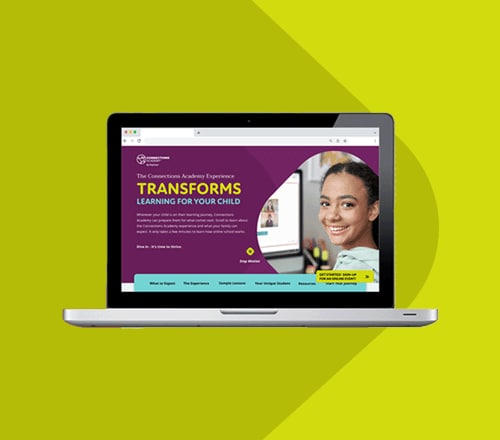How to Get the Most Out of College Visits: a High School Student's Guide
byConnections Academy
7 min to read
Every year, many high school graduates go straight to college after graduating high school. While many students are excited to start building their career skills, college can be about so much more than just getting a degree. For many teens, college is the beginning of the next phase of their life and the first step toward adulthood.
Visiting a college campus can help students feel more prepared, especially if they’re going to be living away from home for the first time or are uncertain what degree program they would like to pursue. To make sure they are set up for success in this pivotal moment, this handy guide can help future college students and their families learn how to get the most out of college visits and choose a school that is the right fit for their personality and future goals.
What Makes an Effective College Visit?
An effective college visit gives students the chance to explore what studying there would be like, including academic expectations and school culture. Additionally, students can evaluate what services, amenities, and support structures a school offers, as well as how easy it is to get around campus and the city or town the school is in.
Students may have to go on multiple visits, speak with current and former students, professors, and admissions officers, to be certain the school is right for them. Ultimately, by the end of the visit, students should have a good understanding of how it feels to actually live and study on campus, and whether or not the school’s degree program matches their academic and career goals.
Creating Your College Visit Shortlist
Creating a list of a student’s must-haves and nice-to-haves for campus life is a great way for them to ensure they get the most out of college visits and helps them prioritize their time as they plan their visit.
When researching schools, it’s a good idea to make a note of the following:
Tuition cost and other expenses like dorm residency and meal plans
Student body size and average class size
Their ideal campus location: Urban? Suburban? Rural?
What sports, Greek life, or clubs are available
Scholarship and financial aid opportunities
Whether most classes are taught by professors or graduate assistants
When Should You Start Planning College Visits?
Students should begin looking at colleges as early in high school as they’d like, though the typical time to start is sometime during their junior year, or the summer between their sophomore and junior years.
Some high schools, including some Connections Academy-supported schools, arrange group field trips to local colleges and universities throughout the year. Families should ask their school counselor for more information.
How Many Colleges Should You Visit Before Choosing a School?
There’s no perfect number of college visits. The key to choosing the right college is to prioritize the must-have features—like degree programs and scholarship opportunities—and to thoroughly consider all the pros and cons of each school. Ideally, students will want to try to look at three or four schools to make sure they’ve explored all their options.

How Often Should You Schedule College Visits?
Ideally, students should plan to schedule college visits throughout the year, so they can get as full a picture of the college or university as possible. If visiting multiple schools, students and families should try to arrange the visits to be around the same time in the semester to ensure they are weighing each school experience equally.
If possible, try to schedule college visits for when the school is in session. Students can opt for a formal guided tour through the school, or they can show up without a guide and walk around on their own to get a sense of what the campus feels like. Though certain buildings or areas may be off-limits without a campus representative, visiting a college or university while classes are in session can allow students to speak to others who attend the school and to see firsthand if the campus culture matches up with their ideal college experience.
If the school’s availability or location makes it tricky to visit in-person, see if the school offers virtual tours. While not the same as an in-person visit, a virtual college tour can be great way to get at least a general sense of a school.
How Long Are College Tours and What Should You Prepare For?
The length of a college tour depends on the school and the type of visit. Individual college tours, where prospective students are guided around the highlights of the school by a student ambassador can be anywhere from 45 to 90 minutes long. Group tours, where students visit classes and are shown some of the school dorms and other amenities as well as Q&As with students or professors can take 3-4 hours. Some universities offer regular open houses for prospective students that can last most of the day or even overnight and often include a more in-depth experience where students learn about specific degree programs, study abroad opportunities, and campus events.
Families should confirm the type of campus visit they are registered for ahead of time with an admissions officer and may want to plan on a variety of experiences as their student explores their options.
Planning a College Campus Visit: Asking the Right Questions
Before visiting a college campus, prospective students should build a list of questions to ask their guide or any other faculty or students they encounter to get the most of the college visit
Some of these questions might be:
What makes this school stand out from the others in the area? Why did you choose to come here?
What do you think of the student support services? How would you rank the academic support available to you?
Where is the best place to study on campus?
What were you surprised to discover after you enrolled?
What is the college’s relationship with the local community?
Where do you go on or off campus outside of class, and what do you do for fun?
Is the school responsive to your needs or when issues arise?
What would you change about the school if you could?
What are the scholarship or internship opportunities?
These and similar questions can give students a better idea of what kind of experience a college offers.
As prospective students move through campus, they might want to also ask about the more practical aspects of college life such as:
How easy is the campus to navigate?
Do the majority of students commute?
Are there multiple campuses? Are all the classes for the degree program offered on the same campus?
How easy is it to travel off campus? What is parking like? How close is campus to public transit?
What safety and security measures are in place?
Is the technology in the classrooms, libraries, or labs up to date?
What clubs, sports, or student organizations are available to incoming students?
Is the campus close to internship or work opportunities?
Choosing the Right College: Making Your Decision
Once a student has completed all their college visits, they will need to re-rank their chosen schools based on what they learned and experienced during the campus tours. Be as objective as possible. While some schools can seem more fun due to the amenities or sports programs, students and families should remember to keep their academic and career goals in mind while making their short list of where they want to apply.

Get a Head Start on College with Online School
Whether students are looking to earn college credit while still in high school or for the flexibility to take their education into their own hands, an online Connections Academy-supported school can help.
Connections Academy® is a tuition-free online public school with more than 20 years of experience helping motivated students succeed as they make their way to college or head right into the workforce. Explore how our College & Career Readiness courses and education partnerships can support your child as they prepare for their next phase of life. Download our free eGuide to learn more.



